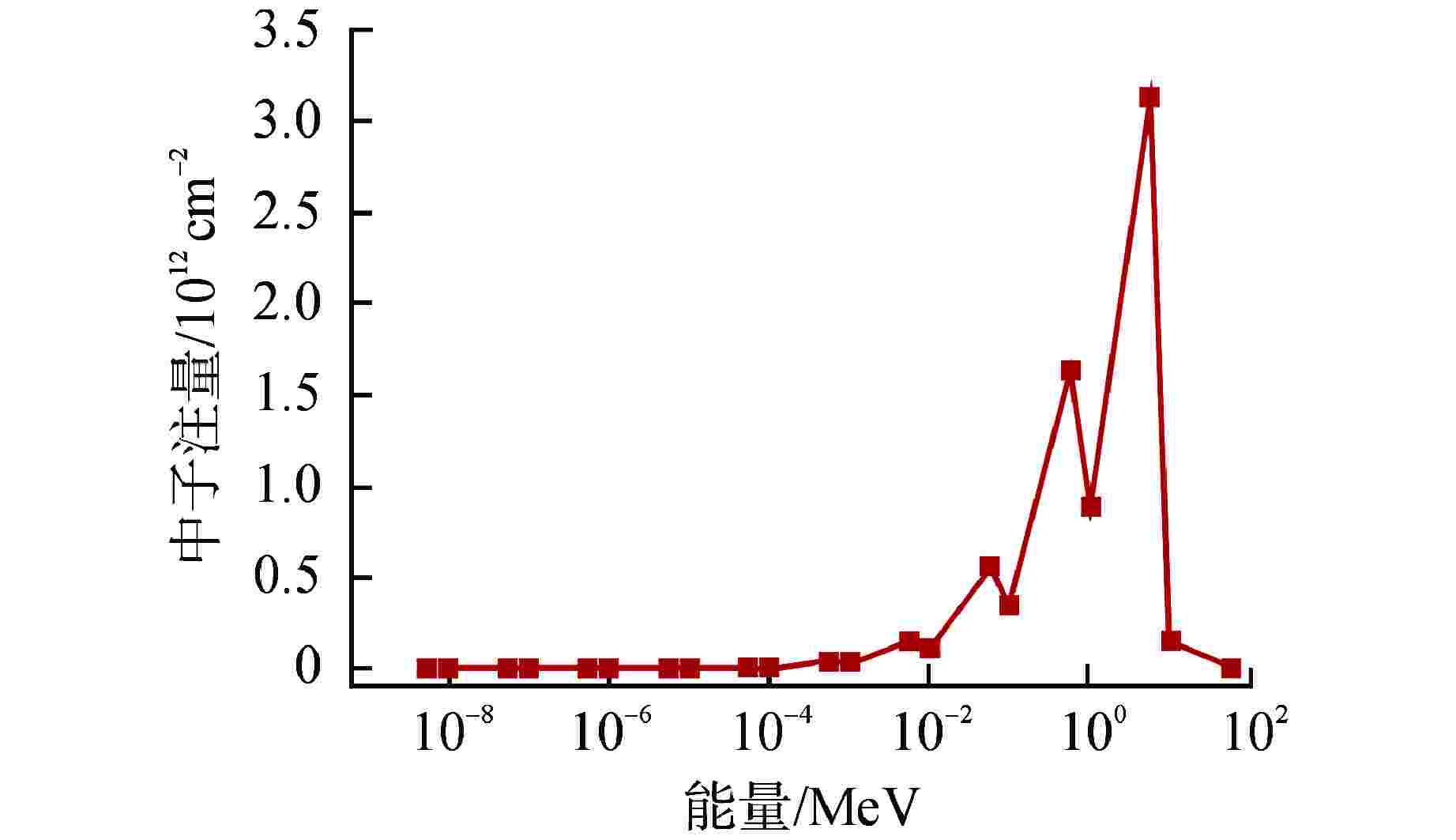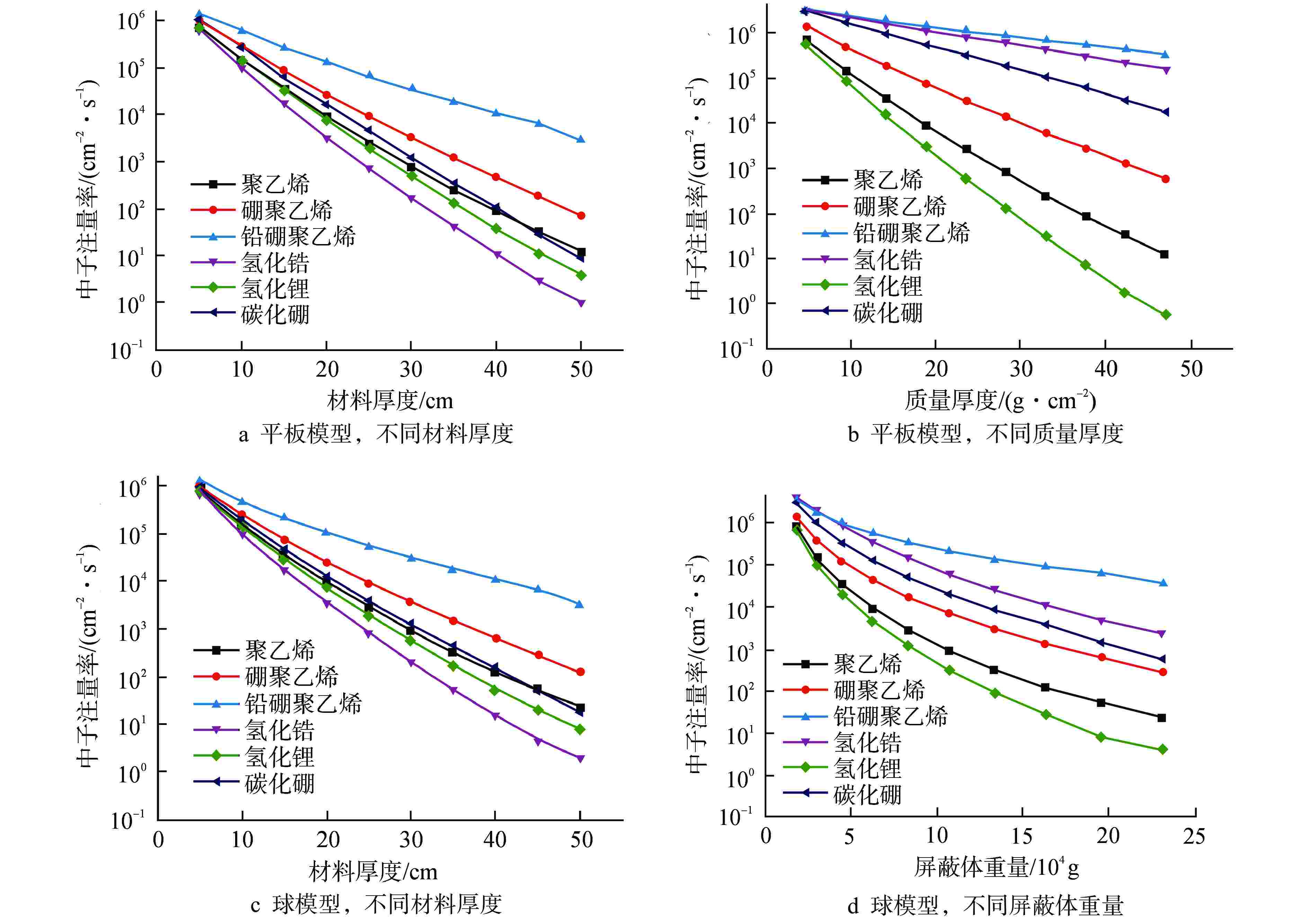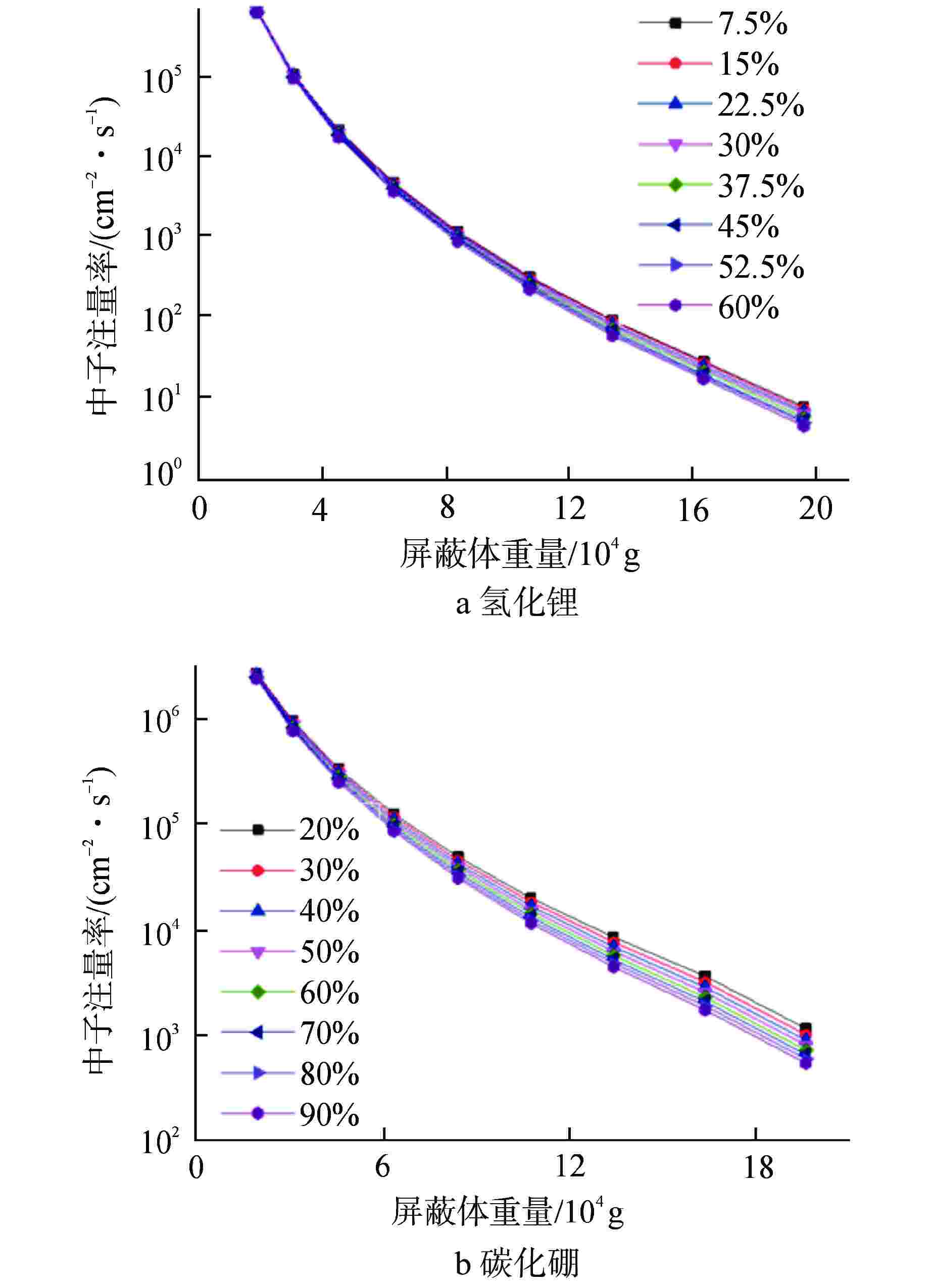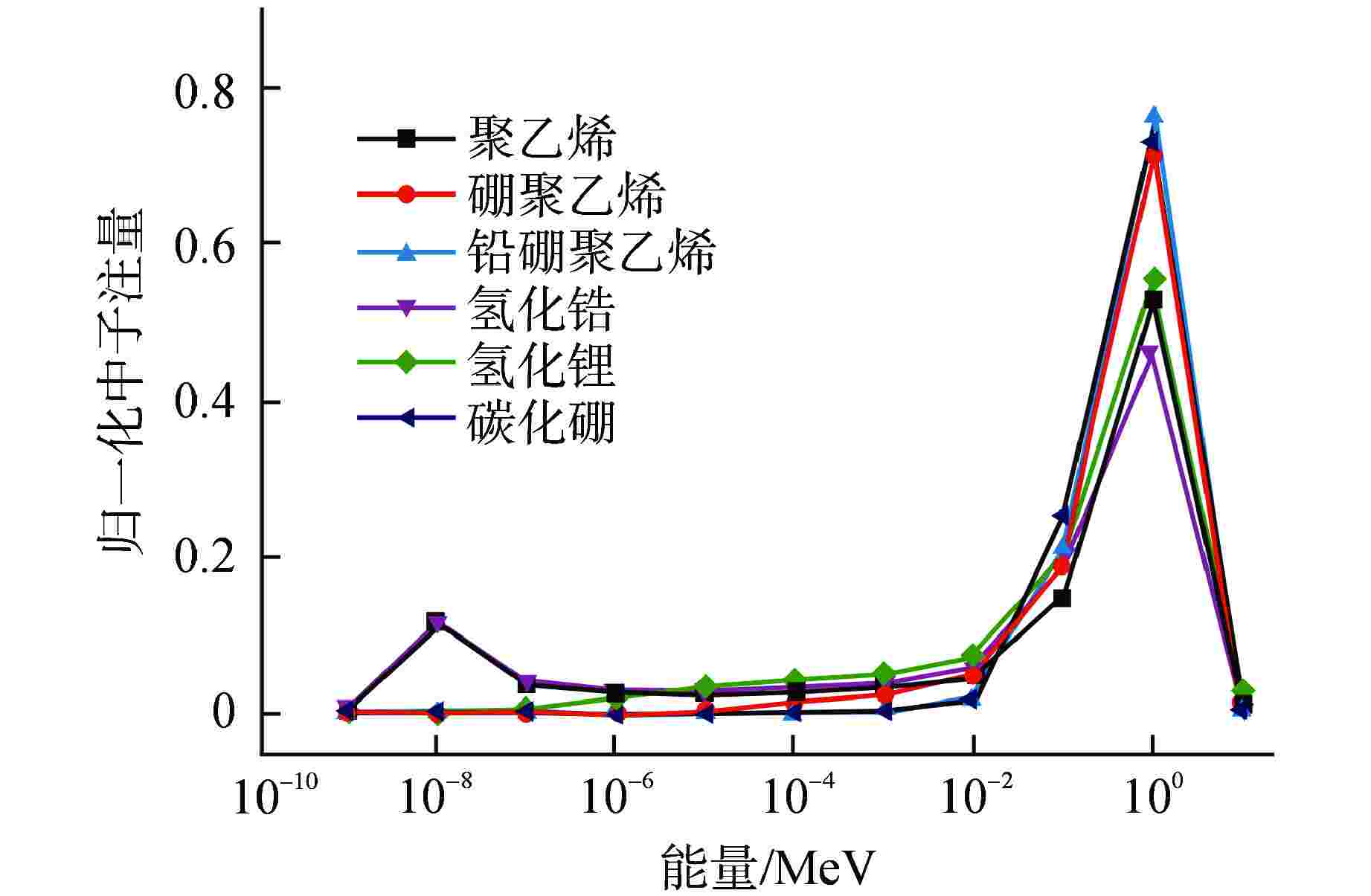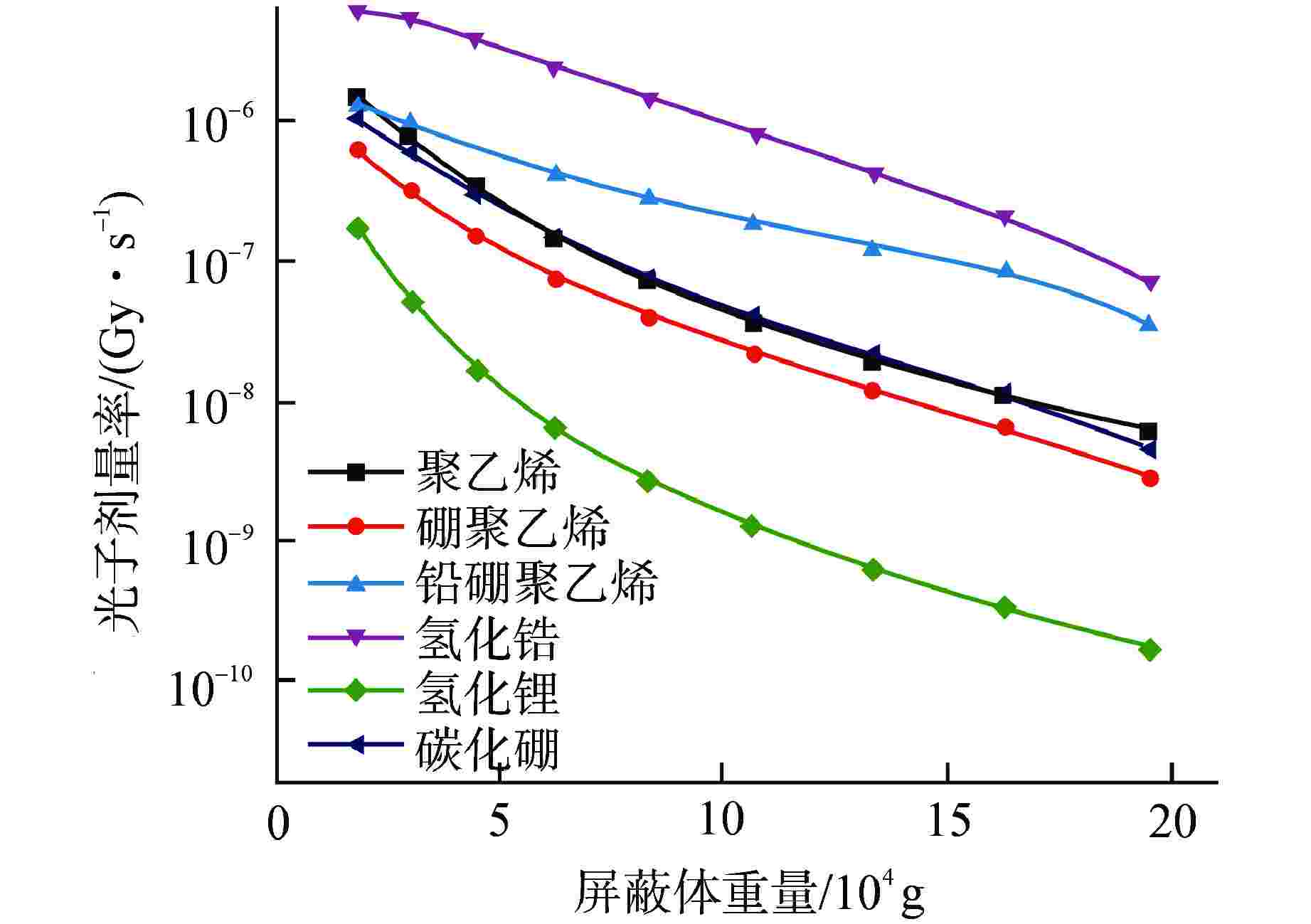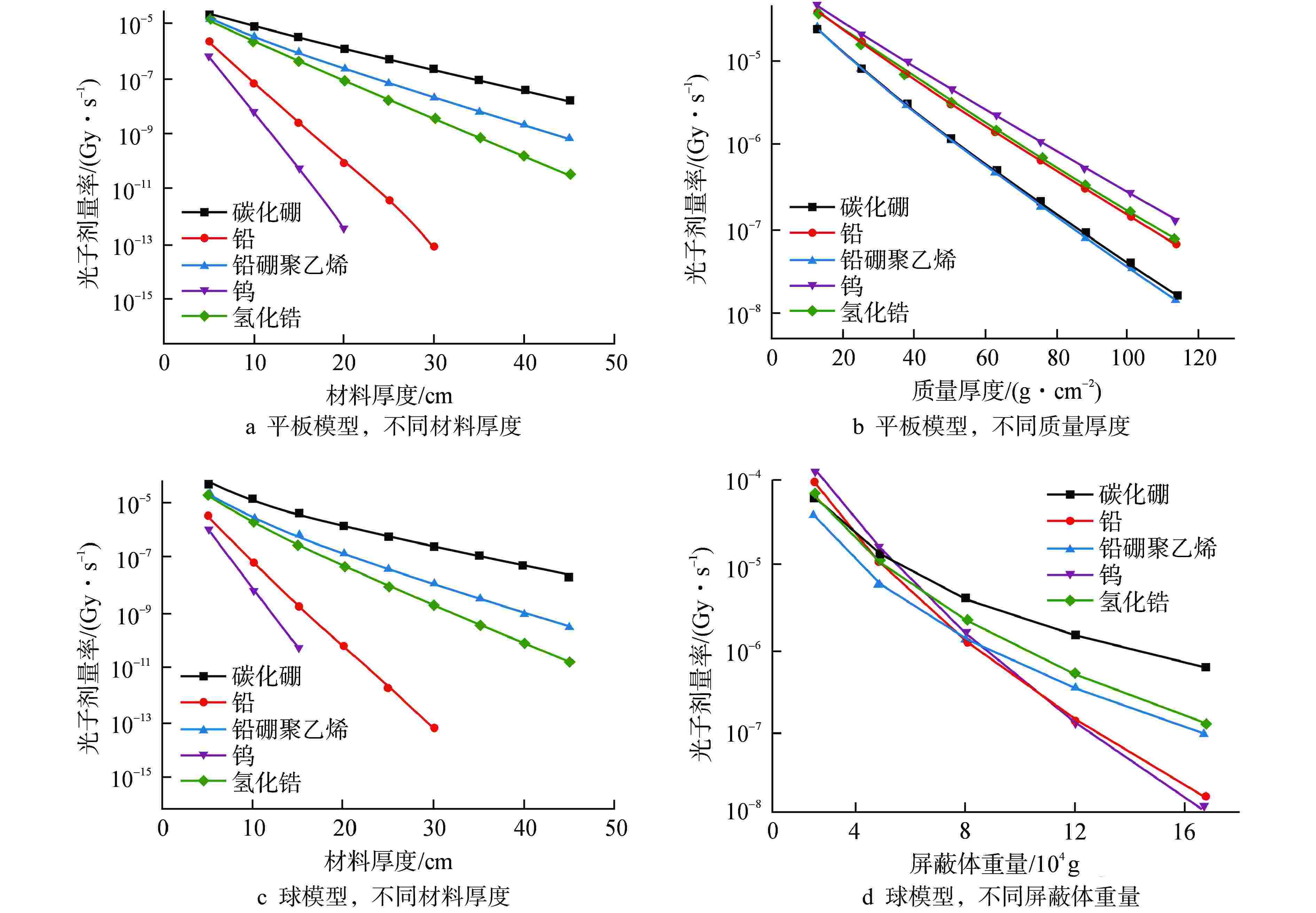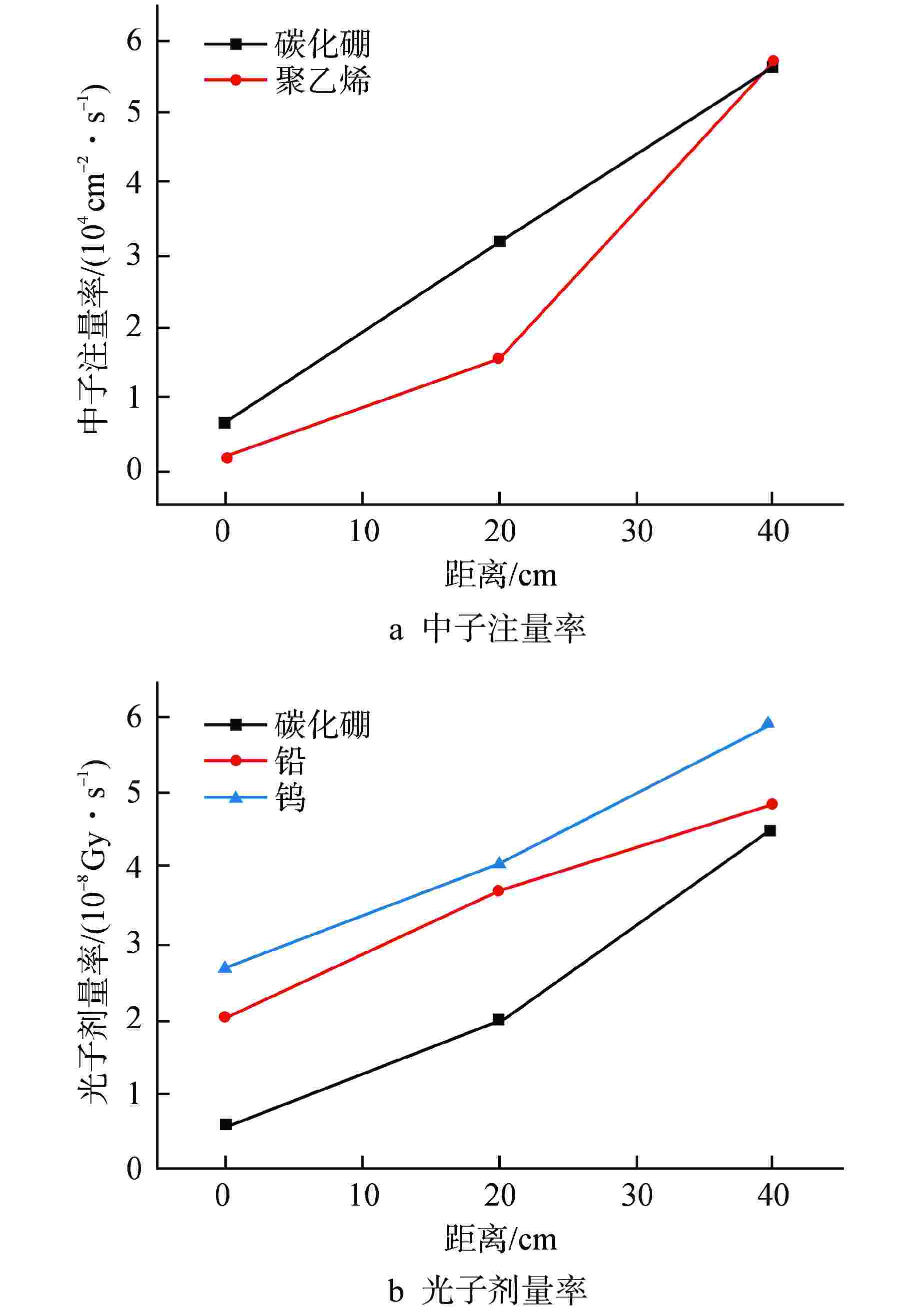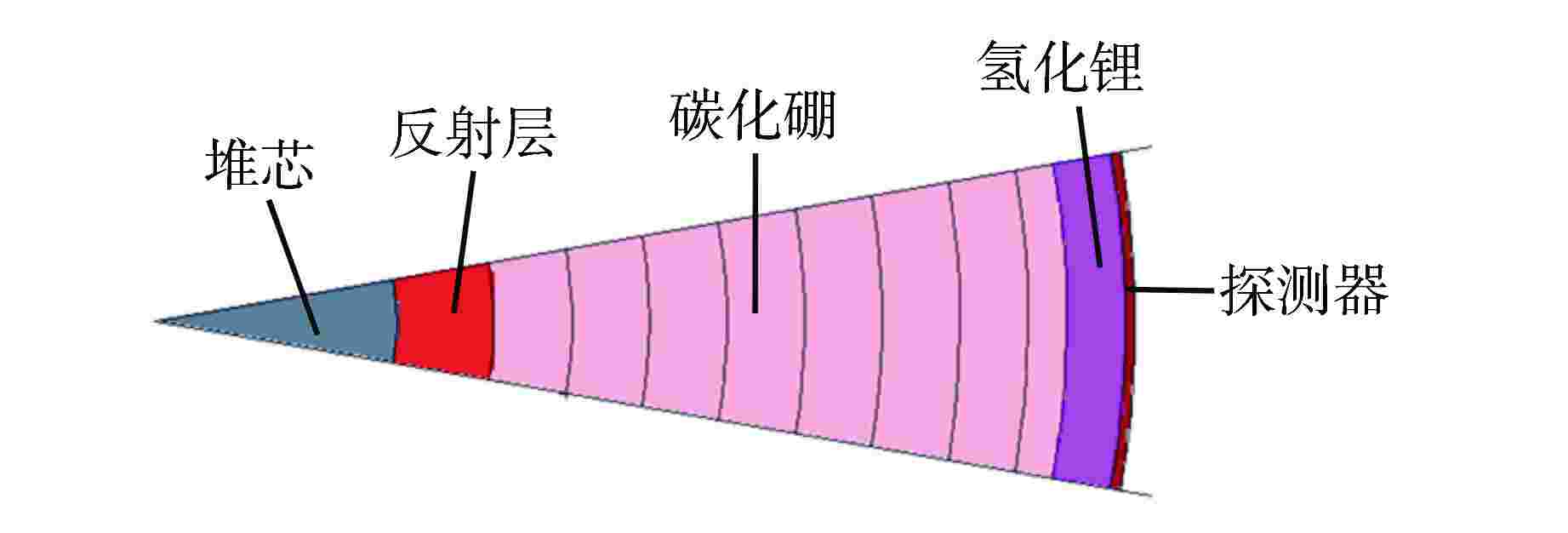Selection of Shadow Shielding Structure and Material for Space Reactor
-
摘要: 空间堆对辐射屏蔽尺寸和重量要求苛刻,为寻找合适的屏蔽方案,需要对屏蔽材料、结构进行选型研究。本文首先介绍了国内外对空间堆屏蔽目标及限值的研究进展,基于反应堆屏蔽设计原理,针对不同应用场景抽象出平板模型和球模型,在不同设计目标下对不同材料的屏蔽性能进行分析,基于分析结果采用自动化优化工具对屏蔽方案进行选型,分析了各个方案的优缺点。结果表明,放射源的能谱、源的尺寸大小、屏蔽体离源的距离、不同的屏蔽设计目标都会影响屏蔽材料和结构的选择,需要根据应用需求进行筛选;碳化硼、氢化锂和钨是较好的空间堆屏蔽材料;利用自动化优化工具对屏蔽体进行分层布置可实现有效减重。Abstract: The space reactor has strict requirements on the size and weight of radiation shielding. In order to find out a suitable shielding scheme, it is necessary to select the shielding material and structure. In this paper, firstly, the research progress of shielding targets and limits of space reactors at home and abroad is introduced. Based on the design principle of reactor shielding, flat model and spherical model are abstracted for different application scenarios, and the shielding performance of different materials is analyzed under different design objectives. Based on the analysis results, automatic optimization tools are used to select shielding schemes, and the advantages and disadvantages of each scheme are analyzed. The results show that the energy spectrum of the source, the size of the source, the distance between the shield and the source, and different shielding design objectives will affect the selection of shielding materials and structures, which needs to be carried out according to the application requirements. Boron carbide, lithium hydride and tungsten are good shielding materials for space reactors, and the use of automatic optimization tools for layered layout of the shield can achieve effective weight reduction.
-
表 1 美国和俄罗斯的空间堆屏蔽目标及限值
Table 1. U.S. and Russian Space Reactor Shielding Targets and Limits
反应堆 国别 年代 屏蔽目标 设计限值 SNAP-10A 美国 1958—1965 电子器件 1×104 Gy
1×1012 cm−2(En>0.1 MeV)TOPAZ-2 苏联/俄罗斯 1972—1992 18.5 m处用户平面 5×102 Gy
1×1011 cm−2
(等效1 MeV中子)SP-100 美国 1983—1990 22 m处用户平面 5×103 Gy
1×1013 cm−2
(等效1 MeV中子)Naval 美国 2002—2005 22 m处用户平面 5×103 Gy
1×1013 cm−2
(等效1 MeV中子)Kilopower 美国 2006— 10 m处用户平面 2.5×102 Gy
1×1011 cm−2(En>0.1 MeV)En—中子动能 表 2 不同电子器件抗中子辐照能力
Table 2. Resistance of Different Electronic Devices to Neutron Irradiation
器件类型 中子注量/cm−2 器件类型 中子注量/cm−2 低频晶体管 1010~1011 整流二极管 1013~1014 中频晶体管 1012~1013 稳压二极管 5×1013~5×1014 高频晶体管 1013~1014 隧道二极管 5×1014~5×1015 可控硅 <1013 逻辑电路 5×1013~1×1015 单结晶体管 5×1011~5×1012 继电器 6.5×1014 线性电路 5×1012 微波器件 1014~1015 结型场效应管 1014~1015 石英晶体 1013~1014 金属氧化物半导体场效应管 1014~1015 阻容元件 1015~1016 金属氧化物半导体电路 5×1014 电真空器件 1015~1017 表 3 不同屏蔽方案的屏蔽效果
Table 3. Shielding Performance of Different Shielding Schemes
方案种类 屏蔽总
重/kg屏蔽体
厚度/cm中子注量率/
(cm−2·s−1)光子剂量率/
(Gy·s−1)聚乙烯+铅 61.2 62+5.6 3.0×106 3.0×10−3 聚乙烯+碳化硅 94.6 43+30.5 2.8×106 3.0×10−3 碳化硼 82.9 67.5 3.1×106 3.3×10−4 碳化硼+氢化锂 67.5 59+6 2.9×106 2.9×10−3 氢化锂+钨 53.9 53+5 3.2×106 2.9×10−3 氢化锂+碳化硅 85.1 34+34 3.0×106 3.1×10−3 氢化锆 106.3 51 2.8×106 1.4×10−4 氢化锆+氢化锂 46.4 26.5+28.5 3.1×106 2.9×10−3 -
[1] 苏著亭, 杨继材, 柯国土. 空间核动力[M]. 上海: 上海交通大学出版社, 2016: 371-430. [2] KRASS A W. Experimental criticality benchmarks for SNAP 10A/2 reactor cores[R]. Oak Ridge: Oak Ridge National Laboratory, 2005. [3] SUSAN S V, GEORGE P D. The pied piper-a historical overview of the U. S. space power reactor program[C]. Space Nuclear Power Conference. Malabar: Orbit Book Company, 1985: 23-30. [4] ANGELO J A JR, BUDEN D. Space nuclear power[M]. Malabar: Orbit Book Co, 1985: 15-130. [5] WOLLMAN M J, ZIKA M J. Prometheus project reactor module final report, for naval reactors information: SPP-67110-0008[R]. Niskayuna: Knolls Atomic Power Laboratory, 2006. [6] ASHCROFT J, ESHELMAN C. Summary of NR program Prometheus efforts: LM-05K188[R]. Niskayuna: Knolls Atomic Power Laboratory, 2006. [7] TAYLOR R. Prometheus project final report: 982-R120461[R]. Pasadena: Jet Propulsion Laboratory, 2005. [8] KOROTEEV A S. New stage in the use of atomic energy in space[J]. Atomic Energy, 2010, 108(3): 170-173. doi: 10.1007/s10512-010-9273-4 [9] DRAGUNOV Y G. Fast-neutron gas-cooled reactor for the megawatt-class space bimodal nuclear thermal system[J]. Engineering and Automation Problems, 2015(2): 117-120. [10] 赵泽昊,安伟健,解家春,等. 用于闭环磁流体发电系统的1MWth空间堆堆芯设计[J]. 科技创新导报,2018, 15(7): 97-99,101. [11] 孟涛,赵富龙,程坤,等. 空间气冷堆堆芯初步物理特性分析[J]. 原子能科学技术,2019, 53(8): 1459-1465. doi: 10.7538/yzk.2018.youxian.0744 [12] 胡彬和,李龙,吴晓春,等. 钼铼合金对掉落临界安全的影响[J]. 原子能科学技术,2016, 50(10): 1813-1816. doi: 10.7538/yzk.2016.50.10.1813 [13] 黄洪涛,王卫军,钟武烨,等. 钼铼合金在空间核电源中的应用性能研究进展[J]. 原子能科学技术,2020, 54(3): 505-511. doi: 10.7538/yzk.2019.youxian.0251 [14] 黄笛,李仲春,余霖,等. 氦氙混合比例对堆内通道流动换热特性影响[J]. 哈尔滨工程大学学报,2021, 42(5): 745-750. [15] 安伟健,霍红磊,李来冬,等. 锂冷空间堆辐照产氦行为研究[J]. 核科学与工程,2020, 40(4): 696-702. doi: 10.3969/j.issn.0258-0918.2020.04.026 [16] 肖成建,陈晓军,康春梅,等. 锂陶瓷氚增殖剂的中子辐照性能与产氚行为[J]. 化学进展,2011, 23(9): 1906-1914. [17] LIU B, LV H W, LI L, et al. Multi-objective optimization design of radiation shadow shield for space nuclear power with genetic algorithm[J]. Frontiers in Energy Research, 2022, 10: 800930. doi: 10.3389/fenrg.2022.800930 [18] AHMAD S, CHANG B, LI B, et al. Mass optimization of the radiation shadow shield for space nuclear power system[J]. Progress in Nuclear Energy, 2021, 131: 103607. doi: 10.1016/j.pnucene.2020.103607 [19] 何宇豪,孟涛,王宪礴,等. 兆瓦级空间反应堆辐射特性分析[J]. 哈尔滨工程大学学报,2021, 42(12): 1726-1732. [20] 张勇. 核电厂辐射防护[M]. 北京: 中国原子能出版传媒有限公司, 2011: 85-124. [21] MOURADIAN E M. Thermal analysis of snap-10a reactor core during atmospheric reentry and resulting core disintegration and fuel element separation. Thermo-physics technical note No. 60: NAA-SR-Memo-11847[R]. Canoga Park: North American Aviation, 1966. [22] POLANSKY G F, HOUTS M G. A preliminary investigation of the topaz II reactor as a lunar surface power supply: SAND-95-2974C[R]. Albuquerque: Sandia National Lab, 1995. [23] DEANE N A, MURATA R E, KRUGER G B. SP-100 reactor design and performance[C]//Proceedings of the 24th Intersociety Energy Conversion Engineering Conference. Washington: IEEE, 1989: 1225-1226. [24] DE HOLANDA MENCARINI L. Mass and shielding optimization studies for a low enrichment uranium fueled kilopower space nuclear reactor[D]. Illinois St: Colorado School of Mines, 2020. [25] 刘磊,袁建东,刘天才,等. 200℃耐辐照电机用聚酰亚胺电磁线的辐照试验研究[J]. 大电机技术,2022(2): 49-54. doi: 10.3969/j.issn.1000-3983.2022.02.009 [26] 常克武,王海涛,张弓,等. 一种基于FPGA的抗辐射加固星载ASIC设计方法[J]. 航天器工程,2016, 25(4): 74-80. doi: 10.3969/j.issn.1673-8748.2016.04.012 [27] 吕继新,陈建廷. 高效能屏蔽材料铅硼聚乙烯[J]. 核动力工程,1994, 15(4): 370-374. [28] 于志翔,邹树梁,徐守龙,等. 基于BP神经网络的船用反应堆屏蔽设计快速计算功能研究[J]. 核电子学与探测技术,2016, 36(2): 209-213. doi: 10.3969/j.issn.0258-0934.2016.02.022 [29] 熊华,范如玉,康克军. 混合辐射场测量中屏蔽设计的组合优化方法[J]. 辐射防护,2006, 26(1): 29-34. doi: 10.3321/j.issn:1000-8187.2006.01.005 [30] 石秀安,刘志宏,胡永明. 中国先进研究堆水平孔道屏蔽设计优化研究[J]. 核动力工程,2006, 27(5): 87-90,93. doi: 10.3969/j.issn.0258-0926.2006.05.019 [31] 贾小波,石秀安. 屏蔽设计组合优化研究[J]. 核科学与工程,2010, 30(4): 338-343. [32] 应栋川,肖锋,张宏越,等. 基于遗传算法的核反应堆辐射屏蔽优化方法研究[J]. 核动力工程,2016, 37(4): 160-164. -





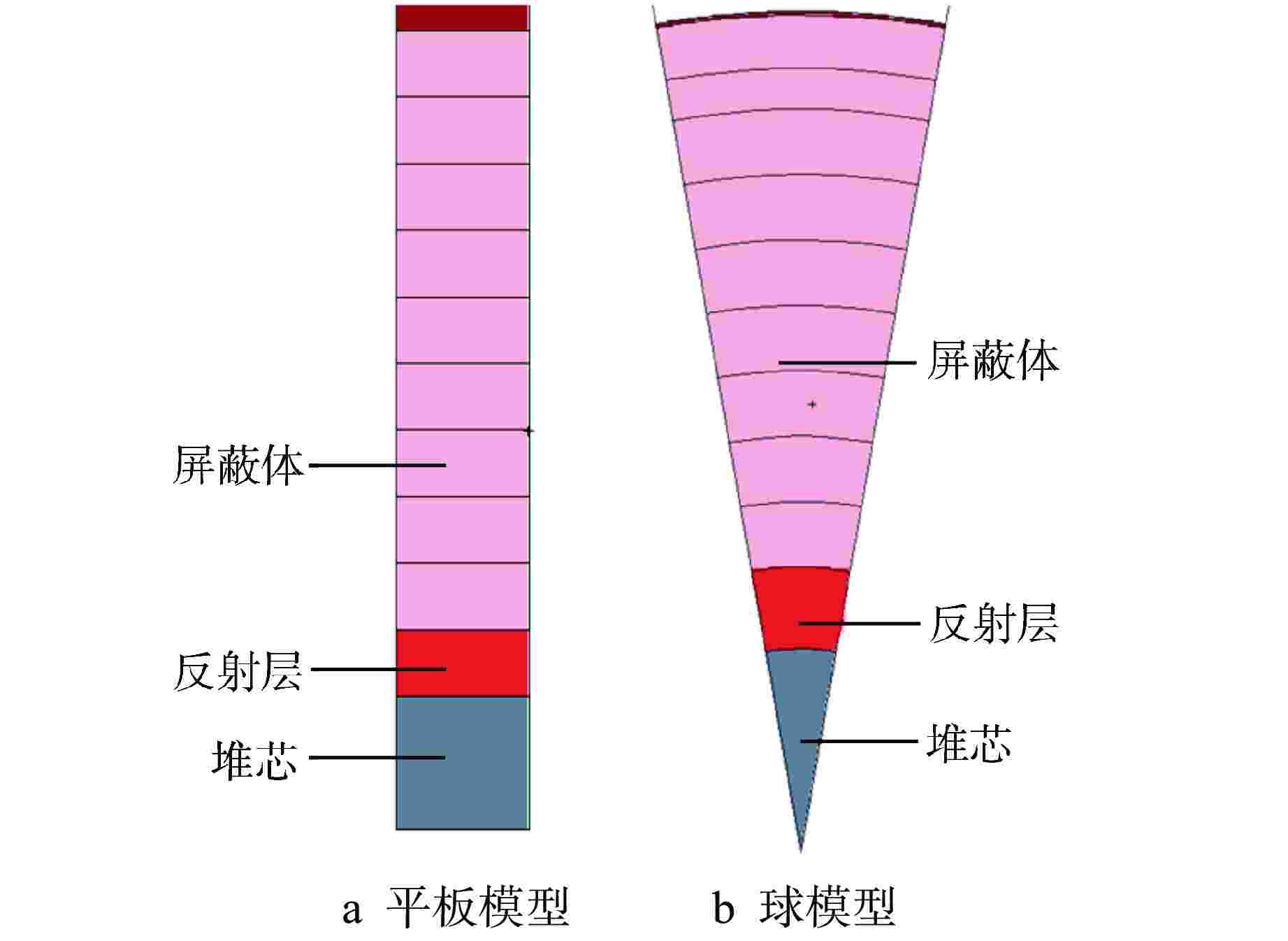
 下载:
下载:
